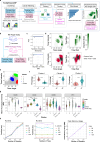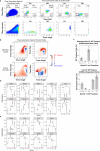Machine learning-assisted decoding of temporal transcriptional dynamics via fluorescent timer
- PMID: 40595611
- PMCID: PMC12219120
- DOI: 10.1038/s41467-025-61279-y
Machine learning-assisted decoding of temporal transcriptional dynamics via fluorescent timer
Abstract
Investigating the temporal dynamics of gene expression is crucial for understanding gene regulation across various biological processes. Using the Fluorescent Timer protein, the Timer-of-cell-kinetics-and-activity system enables analysis of transcriptional dynamics at the single-cell level. However, the complexity of Timer fluorescence data has limited its broader application. Here, we introduce an integrative approach combining molecular biology and machine learning to elucidate Foxp3 transcriptional dynamics through flow cytometric Timer analysis. We have developed a convolutional neural network-based method that incorporates image conversion and class-specific feature visualisation for class-specific feature identification at the single-cell level. Biologically, we developed a novel CRISPR mutant of Foxp3 fluorescent Timer reporter mice lacking the enhancer Conserved Non-coding Sequence 2, which revealed new roles of this enhancer in regulating Foxp3 transcription frequency under specific conditions. Furthermore, analysis of wild-type Foxp3 fluorescent Timer reporter mice at different ages uncovered distinct patterns of Foxp3 expression from neonatal to aged mice, highlighting prominent thymus-like features of neonatal splenic Foxp3+ T cells. In conclusion, our study uncovers previously unrecognised Foxp3 transcriptional dynamics, establishing a proof-of-concept for integrating CRISPR, single-cell dynamics analysis, and machine learning methods as advanced techniques to understand transcriptional dynamics in vivo.
© 2025. The Author(s).
Conflict of interest statement
Competing interests: A patent associated with the ML method in this study has been filed (MO). The remaining authors declare no competing interests.
Figures









Similar articles
-
Genome-wide CRISPR screen in human T cells reveals regulators of FOXP3.Nature. 2025 Jun;642(8066):191-200. doi: 10.1038/s41586-025-08795-5. Epub 2025 Mar 26. Nature. 2025. PMID: 40140585
-
Novel non-coding FOXP3 transcript isoform associated to potential transcriptional interference in human regulatory T cells.RNA Biol. 2025 Dec;22(1):1-20. doi: 10.1080/15476286.2025.2502719. Epub 2025 Jul 2. RNA Biol. 2025. PMID: 40605177 Free PMC article.
-
Comprehensive single-cell chromatin and transcriptomic profiling of peripheral immune cells in nonsegmental vitiligo.Br J Dermatol. 2025 Jun 20;193(1):115-124. doi: 10.1093/bjd/ljaf041. Br J Dermatol. 2025. PMID: 39888372
-
Systemic pharmacological treatments for chronic plaque psoriasis: a network meta-analysis.Cochrane Database Syst Rev. 2021 Apr 19;4(4):CD011535. doi: 10.1002/14651858.CD011535.pub4. Cochrane Database Syst Rev. 2021. Update in: Cochrane Database Syst Rev. 2022 May 23;5:CD011535. doi: 10.1002/14651858.CD011535.pub5. PMID: 33871055 Free PMC article. Updated.
-
Drugs for preventing postoperative nausea and vomiting in adults after general anaesthesia: a network meta-analysis.Cochrane Database Syst Rev. 2020 Oct 19;10(10):CD012859. doi: 10.1002/14651858.CD012859.pub2. Cochrane Database Syst Rev. 2020. PMID: 33075160 Free PMC article.
References
MeSH terms
Substances
Grants and funding
- DCRPGF\100007/Cancer Research UK (CRUK)
- JP21K07082, JP21H00433, JP24K10259, JPJSCCA2020008/MEXT | Japan Society for the Promotion of Science (JSPS)
- JPJSCCA2020008/MEXT | Japan Society for the Promotion of Science (JSPS)
- JP16H0627601, JP22H04922/MEXT | Japan Society for the Promotion of Science (JSPS)
- 24gm1810001s0103/Japan Agency for Medical Research and Development (AMED)
LinkOut - more resources
Full Text Sources

